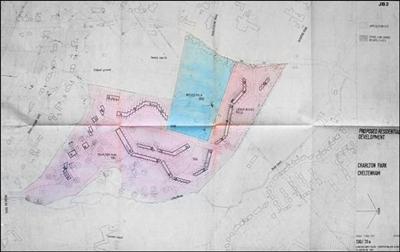It was then decided to attempt direct talks between the Chairmen of the College Finance and General Purposes Committee with the County Planning Officer, Borough officials and representatives of the Joint Planning Committee. The author has been unable to locate the minutes of this meeting due to the passage of time but it was held on 10 May 1966 and that is when the County Planning Department produced a model they had prepared for 240-250 dwelling units in Charlton Park. The proposals in the model included a number of 10-storey and 5-storey blocks of flats, some terraced housing and some individual housing, all with a single access road from Old Bath Road and, interestingly, the model was welcomed by the no doubt wearied College representatives.
An inspection of the trees was arranged but efforts to reach agreement with the East Gloucester Tennis Club concerning land which might be useful for the access road met with no success. Subsequent plans allocated a 46' strip of College land along the edge of Reeves' Field, not requiring land from the East Gloucester Tennis Club, and at the same time it was still proposed that a second access be sought from Moorend Road, leading to some twelve high quality houses (similar to those in Charlton Park Gate). County officials initially agreed to the Moorend Road access providing small amounts of ground could be obtained as 'sight' lines from the Convent and an adjacent property, on both sides of the access point.
 © Cheltenham CollegeProposed access to the 'exclusive' end of Charlton Park was to the rear of Brook House, Moorend Road
© Cheltenham CollegeProposed access to the 'exclusive' end of Charlton Park was to the rear of Brook House, Moorend Road
In 1967 an application was submitted for outline planning permission for 19 high class houses at the Moorend Road end of Charlton Park with access to Moorend Road. This was refused on the grounds that the application did not comply with the outline form of the development suggested by the County Planning Department in 1966 (for 12 houses) and that the construction of an access road on this part of Moorend Road would be undesirable and dangerous. By now Cheltenham College had submitted several planning applications in as many years, all being refused. After the latest refusal, a person acting for the College in relation to the building of staff houses was instructed to obtain the Borough Engineer's agreement to the major access point from Old Bath Road, near to an existing access point to Reeves Field and without requiring any land from the East Gloucester Tennis Club. The failure to gain access from Moorend Road caused him to comment to the effect that, 'with this proposed access now prohibited for high class houses at the east end of Charlton Park it would require their owners to come and go through the higher density part of the development and this would make it difficult to obtain good prices for high quality houses because of the poor approach and because the high density part of the development would still be under construction'. As if Cheltenham College had not already planned for sufficient topographical damage in the park via their city architect's drawing boards, it appears that in addition to (Reeves) un-level playing field nearby, at least one of those involved sought to create a metaphorical equivalent for the remainder of Charlton Park by separating the intended professionals' houses at one end from mere proletariat housing at the other. This smacks of urban apartheid and because the rest of the world had moved on considerably since the 1940s, the author will refrain from making further comment on such divisive plans in modern post-war Britain.
 © Cheltenham CollegeA College development plan of 1969 incorporating Lower Reeves Field with access from Old Bath Road
© Cheltenham CollegeA College development plan of 1969 incorporating Lower Reeves Field with access from Old Bath Road
A situation had now been reached where the model put forward by the County Planning Committee (without access details) was unacceptable to the College and their agents in London and things slowly ground to a complete halt. Half a century on, with no access to the decision makers of the time, it is reasonable to conclude that almost a decade of setbacks may have persuaded Cheltenham College to desist from making further applications. Having already received Counsel's Opinion not to appeal with a view to creating their prestigious housing development in Charlton Park, the resultant ennui flowing from this long and drawn out process appears to have finally encouraged the College to put the land on the open market, leaving it for others to tackle the seemingly insuperable planning obstacle course.
